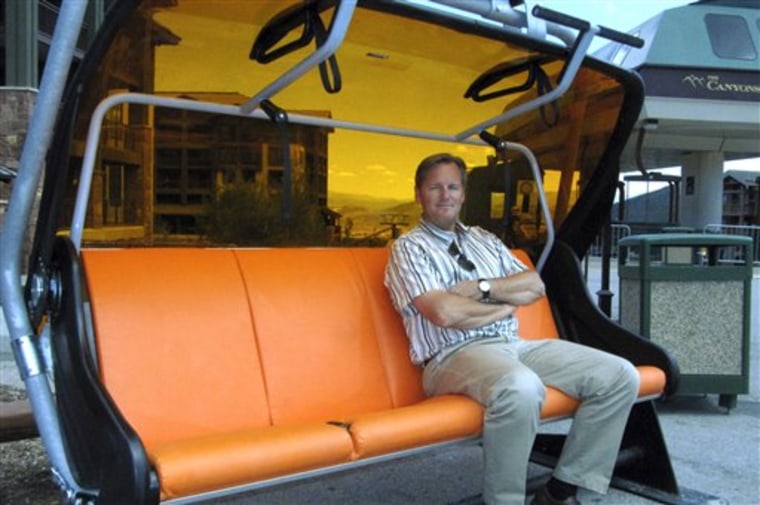Utah's fastest growing ski area is spending millions of dollars to reconfigure the mountain and add North America's first heated chair lift with a bubble shield that swings over passengers like a pair of orange goggles.
The changes at The Canyons, one of Park City's three ski resorts, highlight some of the biggest development projects or plans at Utah ski areas since the 2002 Salt Lake Olympics drove major expansions.
The resorts are moving despite the down economy and saving on construction costs because of it. Ultimately they hope to steal market share from Colorado, which draws three times as much skier traffic. Utah's resorts, with advantages like double Colorado's snowfall and a short drive from Salt Lake City's airport, aren't shy about making investments.
"This is the future," Mike Goar, managing director of The Canyons, said at the base of the 4,000-acre resort as bulldozers reshaped land for new lift terminals and outdoor patios. "The experience will be so different — it will be like a new resort. The big story is the faith we have in the potential of The Canyons."
The Canyons is owned by Toronto-based Talisker Corp., a closely held resort operator that won't reveal how much it is spending. Executives say it is one of the biggest investments by a North American ski operator in years.
The Canyons was considered so valuable that when Talisker bought it two years ago for $123 million, Colorado rival Vail Resorts Inc. filed a lawsuit claiming it had a deal to buy the Park City resort from now-defunct American Skiing Co. but was pushed aside. Vail dropped the lawsuit a year later but grumbled that it reserved the right to seek monetary damages.
Now, Talisker is on a tight schedule to remake Utah's largest ski resort by December. It is opening an eighth peak for skiing and adding or realigning several lifts, while redesigning the village base.
The main lift, an eight-passenger gondola, is being moved closer to an aerial cabriolet that picks up skiers from a parking lot.
Also at the base, the resort is adding a high-speed chair lift with seats that can heat up to about 55 degrees. That could change skiers' outlook on a frigid winter day. A bubble shield will keep the wind off as skiers sail high onto the mountain in nine minutes.
The lift is the envy of other Utah resorts, but others have big plans, too.
Snowbird, in the mountains just east of Salt Lake City, and Snowbasin near Ogden have filed plans for major expansions with local governments or the U.S. Forest Service.
Snowbird is an especially steep ski area that is Utah's most challenging and wants to go higher. It has proposed a second passenger tram from its 11,000-foot summit to a 11,489-foot peak nearby.
It would open hundreds of acres of new terrain for skiing. The new tram is among a number of changes Snowbird filed in May with a master plan to the Forest Service for approval. The full plan would take 10 years to realize.
Snowbasin has even bigger plans for all-season resort development that spill far outside its boundaries onto private land acquired over the years by owner Earl Holding, who initially spent about $200 million to make Snowbasin an Olympic mountain — it held the downhill races in 2002.
Now, Snowbasin wants to add golf courses, hiking and horseback trails and 5,500 housing and hotel units. It also plans lift upgrades and a second base area on the mountain.
"We have a lot of faith in the future," said Kent Lyons, Snowbasin's general manager. "It's not a bad time to do construction now if you can afford to do it."
Last year Utah's resorts drew skiers for just over 4 million visits and generated $1 billion in spending for the state's economy. Colorado drew nearly 12 million skier visits.
Among other Utah resorts sprucing up their mountains:
- Park City Mountain Resort is adding snowmaking on the lower mountain and brighter lights for more night skiing terrain. The resort says it's spending $4.5 million on those and other improvements, and saving on more efficient night lighting.
- Deer Valley, the perennial favorite of Ski magazine — it has earned readers' No. 1 ranking for three years in a row — says it's investing $4.5 million in mountain amenities this year. It's updating the interiors of ski lodges and replacing equipment including snowmaking machines with more energy-efficient models.
- Brighton Resort says it has invested $5 million in ski lifts over the past few years.
- Alta, Utah's legendary powder palace, hardly ever needs improvement, but the ski area is planting trees, shrubs, mountain flowers and grasses. It's upgrading snowmaking capacity and overhauling a quaint rope tow that pulls skiers between base areas.
- Powder Mountain, about 20 miles northeast of Ogden, is expanding popular snowcat-assisted backcountry terrain for a total of 7,000 skiable acres. The Canyons, with 4,000 lift-serviced acres, claims to be Utah's largest. Powder says it's bigger, but skiers there have to climb, shuffle along mountain ridges or get pulled by a snowcat to reach much of the terrain.
